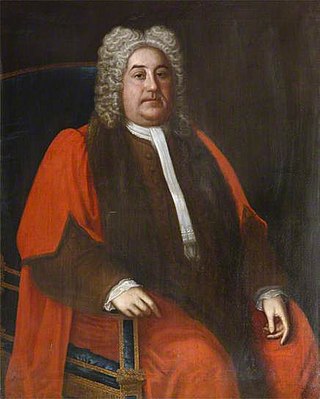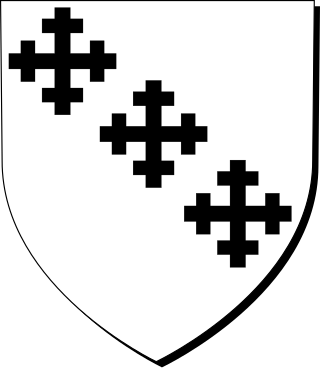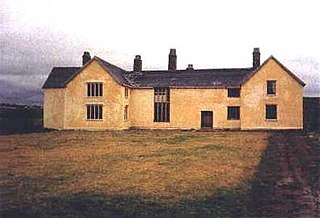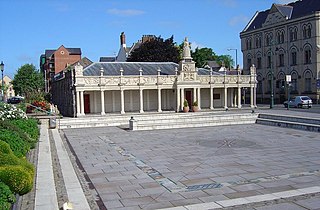
Pilton is a suburb of the town of Barnstaple, it is located about quarter of a mile north of the town centre, in the civil parish of Barnstaple, in the North Devon district, in the county of Devon, England. It was formerly a separate village. The civil parish of Pilton West covers the more rural parts of the ancient parish of Pilton that have not been incorporated into the town of Barnstaple. In 2009, the Pilton (Barnstaple) ward had a population of 4,239 living in some 1,959 dwellings. It has its own infants and junior school, houses one of Barnstaple's larger secondary schools, and one of Barnstaple's SEN specialist schools. North Devon Hospital is also within West Pilton parish. It has a Church Hall, two public houses, two hotels, and residential homes. It has residential estates of both private and public housing including flats. It also has a historic Church that dates back to at least the 11th Century.

Goodleigh is a village, civil parish and former manor in North Devon, England. The village lies about 2+1⁄2 miles (4 km) north-east of the historic centre of Barnstaple. Apart from one adjunct at the south, it is generally a linear settlement.

Benjamin Incledon (1730–1796) of Pilton House, Pilton, near Barnstaple in North Devon, was an English antiquarian and genealogist. He served as Recorder of Barnstaple (1758–1796).

Colleton is a hamlet and former manor in the civil parish and ecclesiastical parish of Chulmleigh, in the North Devon district of Devon, England. It is situated on the north side of a valley containing the River Taw. Its nearest town is Chulmleigh, which lies approximately 3.6 miles (5.8 km) to the south-west. It consists of the grade I listed Colleton Barton and Colleton Mill, the former manorial mill, with another former industrial building situated at the approach to the bridge over the River Taw.

Sir John Carew, 3rd Baronet of Antony, Cornwall, was an English politician who sat in the House of Commons variously between 1660 and 1692.

Hall is a large estate within the parish and former manor of Bishop's Tawton, Devon. It was for several centuries the seat of a younger branch of the prominent and ancient North Devon family of Chichester of Raleigh, near Barnstaple. The mansion house is situated about 2 miles south-east of the village of Bishop's Tawton and 4 miles south-east of Barnstaple, and sits on a south facing slope of the valley of the River Taw, overlooking the river towards the village of Atherington. The house and about 2,500 acres of surrounding land continues today to be owned and occupied by descendants, via a female line, of the Chichester family. The present Grade II* listed neo-Jacobean house was built by Robert Chichester between 1844 and 1847 and replaced an earlier building. Near the house to the south at the crossroads of Herner the Chichester family erected in the 1880s a private chapel of ease which contains mediaeval woodwork saved from the demolished Old Guildhall in Barnstaple.

The landed gentry and nobility of Devonshire, like the rest of the English and European gentry, bore heraldic arms from the start of the age of heraldry circa 1200–1215. The fashion for the display of heraldry ceased about the end of the Victorian era (1901) by which time most of the ancient arms-bearing families of Devonshire had died out, moved away or parted with their landed estates.
Lieutenant-Colonel John Lambrick Vivian (1830–1896), Inspector of Militia and Her Majesty's Superintendent of Police and Police Magistrate for St Kitts, West Indies, was an English genealogist and historian. He edited editions of the Heraldic Visitations of Devon and of Cornwall, standard reference works for historians of these two counties. Both contain an extensive pedigree of the Vivian family of Devon and Cornwall, produced largely by his own researches.

Sir Henry Northcote, 4th Baronet (1655–1730) was an English baronet from Devon. He was by profession a doctor of medicine. His great-great-great-grandson was Stafford Northcote, 1st Earl of Iddesleigh (1818–1887).

John II Clevland of Tapeley in the parish of Westleigh, Devon, was seven times Member of Parliament for Barnstaple from 1766 to 1802.

Rashleigh is an historic former manor in the parish of Wembworthy, Devon. Rashleigh Barton, the former manor house, is a grade II* listed building, situated 5 miles north-east of the village of Wembworthy. It was the earliest known seat of the ancient Rashleigh family, a junior branch of which is still seated at Menabilly in Cornwall, and in the 16th century, on the failure of the male line, passed from the senior line of the Rashleigh family via a sole heiress to the Clotworthy family of Clotworthy in the same parish of Wembworthy.

Buckland in the parish of Braunton, North Devon, England, is an ancient historic estate purchased in 1319 by Godfrey II de Incledene of Incledon, the adjoining estate about 1/2 mile to the north-west, whose family, is first recorded in 1160. It is situated half a mile north-west of St Brannock's Church in Braunton. Buckland House, a grade II* listed mansion remodelled in the 18th century, is still occupied in 2014 by descendants of the Incledon-Webber family, formerly prominent in the political and commercial life of nearby Barnstaple and North Devon. The owner of the estate in 1937, William Beare Incledon-Webber was also lord of the manor of nearby Croyde and Putsborough.

Pilton House in the parish of Pilton, near Barnstaple, North Devon, Ex31, is an historic grade II listed Georgian mansion house built in 1746 by Robert Incledon (1676-1758), twice Mayor of Barnstaple, who was from nearby Braunton. It is situated almost in the centre of the ancient town of Pilton, but had formerly extensive grounds covering at least 20 acres, which extended down "Pilton Lawn", now built over, to the River Yeo. It later served as the residence for various Members of Parliament for Barnstaple, for which it was well suited being only a 10-minute walk from the centre of that town, yet in a secluded situation with extensive grounds, and sufficiently large and grand for entertaining borough officials and electors.

Robert Incledon (1676–1758) of Pilton House, Pilton, near Barnstaple in North Devon, was a lawyer of New Inn, London, a Clerk of the Peace for Devon, Deputy Recorder of Barnstaple and was twice Mayor of Barnstaple, in 1712 and 1721. In 1713 as mayor he supervised the building of the Mercantile Exchange on Barnstaple Quay, as recorded on the building by a contemporary brass plaque and sculpture of his armorials. He built Pilton House in 1746.

Queen Anne's Walk is a grade I listed building in the town of Barnstaple, North Devon, completed in 1713 as a meeting place for the town's merchants. It is believed to have been designed by the architect William Talman, on the basis of its similarity to his work at the Hall in Drayton, Northamptonshire. It was promoted and financed by the thirteen members of the Corporation of Barnstaple whose armorials are sculpted on and above the parapet, and the work was overseen by Robert Incledon (1676–1758), Mayor of Barnstaple in 1712–13. It has been owned for many decades by North Devon District Council, which currently (2014) leases it to Barnstaple Town Council, and now trades as The Cafe on the Strand.

Sir Nicholas II Hooper (1654-1731) of Fullabrook, Braunton and Raleigh, Pilton in Devon, was a lawyer who served as Tory Member of Parliament for Barnstaple 1695-1715.

The recorder of Barnstaple was a recorder, a form of senior judicial officer, usually an experienced barrister, within the jurisdiction of the Borough of Barnstaple in Devon. He was usually a member of the local North Devonshire gentry. The position of recorder of any borough carried a great deal of prestige and power of patronage. The recorder of a borough was often entrusted by the mayor and corporation to nominate its Members of Parliament, as was the case with Sir Hugh I Pollard, Recorder of Barnstaple, who in 1545 nominated the two MP's to represent the Borough of Barnstaple. In the 19th century a recorder was the sole judge who presided at a Quarter Sessions of a Borough, a "Court of Record", and was a barrister of at least five years' standing. He fixed the dates of the Quarter Sessions at his own discretion "as long as he holds it once every quarter of a year", or more often if he deemed fit.

Henry Northleigh (1643–1694) of Peamore in the parish of Exminster in Devon, was thrice MP for Okehampton in Devon.

Richard Coffin (1623–1700) of Portledge in the parish of Alwington in North Devon, was lord of the manor of Alwington and served as Sheriff of Devon in 1683.
The lord of the manor of Swimbridge in Devon, England, until the 20th century was the Duke of Bedford, of Woburn Abbey in Bedfordshire and of Endsleigh Cottage in Devon, whose ancestor John Russell, 1st Earl of Bedford (c.1485–1555) of Chenies in Buckinghamshire and of Bedford House in Exeter, Devon, was appointed Lord Lieutenant of Devon by King Henry VIII and obtained large grants of land in that county following the Dissolution of the Monasteries. Thus there is no manor house in Swimbridge as the lord was non-resident. The location of the court house where manorial business was transacted may have been Ernesborough.



















